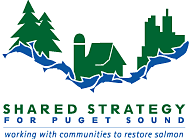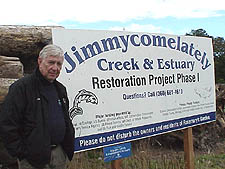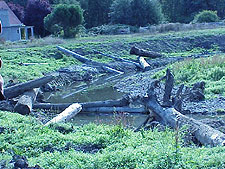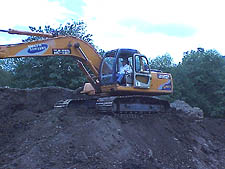|
Regular Folk with a Penchant for Place Embrace Salmon Recovery in a New Way By Taylor Pittman It was December 1996 and Hwy 101 was flooded at the bridge between Blyn Crossing and Sequim, WA. People were stranded on both sides—in their cars, and in their homes. No one had ever seen Jimmycomelately Creek (JCL) rise so high, nor did they ever want to again.
Pearl Severn, an 86-year resident of the area, said the sheriff came to rescue her and her two dogs at 3 a.m. with his lights flashing, but she wouldn’t leave her home. “I knew from experience that the water would drain away in another direction, not over my land. My front steps were covered and the garage was full of mud, but my house was fine.” The fateful morning after the flood Randy Johnson, a Washington Department of Fish and Wildlife biologist, and John McLaughlin, the property owner adjacent to the creek just above the flooding bridge area, met. Both men were out sloshing in the flood’s muddy aftermath. “You know, John, this isn’t the original creek channel” Randy said, “but it looks like that’s what the water needs.” Randy knew that after WWII the JCL creek had been confined in a rock-lined channel in an attempt to control it. Then, in the early 1950s, the channel had been moved and straightened to divert it for irrigation. Known as “channelization,” this method increases the slope of the flowing water by confining it to a smaller area at a higher elevation. This increased slope causes the water to flow more quickly. Sometimes when this method is used, as in the case of JCL, flooding occurs more frequently downstream because the water overrides the channel’s banks. In all cases, it reduces fish habitat when the wood and gravel are washed out and the flow speed increases. Another consequence of channelization is that streams separate from their floodplains and, during high flow events; water is unable to spread onto the floodplain and slow down. These high flow, high velocity events, can scour the stream even more, washing out suitable spawning gravels and salmon redds. The high flows can also wash away wood that may have fallen into the stream, further simplifying, or degrading, the habitat for fish. In that moment of recognizing that the JCL was not working for fish OR for people, six years of hard work and the largest meandering stream restoration project in western Washington began. County, tribal, state, private and federal cooperators galvanized to put the Jimmycomelately creek back into its original meandering shape--diminishing flood risk and restoring prime habitat to the federally-listed (as threatened under the Endangered Species Act) summer chum salmon. Also to be completed are the removal of two roads and a new Highway 101 bridge which will span the entire 100 feet of floodplain and the restored creek bed. Pearl remembers the abundance of chum in the early days: “I could hear them at night from my bedroom window—splashing away.”
To assist this declining, nearly extinct population, the Washington Department of Fish and Wildlife, with the help of over 30 volunteers, began capturing spawning chum to obtain and fertilize their eggs and establish an augmentation program. In 2003, almost 87,000 eggs were collected from the captured mature summer chum while 460 others traveled upstream to spawn naturally. “It was the right thing to do, AND it was fascinating” says John McLaughlin, explaining why he chose to participate in years of technical meetings when, as a retiree, he could be out fishing. “This project was full of competent, willing folks. I had never been involved in a private/governmental project before. No one agency or individual was the ‘leader.’ We all took equal ownership of the problem and did our best to work toward a solution.” Dave Shreffler, a biological consultant to the creek project, said “It was a ground-up, not top-down solution. The permitting agencies had never encountered anything like it. Typically, one group or agency becomes the “lead,” taking responsibility and credit for what happens. This can often lead to stalemating, getting bogged down in power-struggles, lack of staff to follow through promptly, or lack of interest on the part of others who aren’t “responsible.” In this case, just the opposite occurred: many people with local place-based knowledge took initiative and responsibility, followed through, and were empowered by the group. Lyn Muench, a Jamestown S’Klallam tribe planner, attributes the success of such a complex project to synergistic events over the years.
“Many, many things changed over time and each time they did, the agencies involved made the necessary adjustments in staff and financial investment to keep progress happening. They saw the bigger picture and rolled with the punches.” Muench said. “As a result, I’d say we experienced something extraordinary; I’d call it ‘creative bureaucracy.’” Also unusual was the ecological and long-term view that project proponents took. Most stream restoration projects don’t, or can’t (due to location and/or land ownership), consider the estuary (where the creek meets the bay) and the importance of its vegetation, productivity, and tidal-driven hydrology with its associated bay. The JCL Creek project always had the estuary in mind and endured long enough for circumstances to shift to its advantage. Economic conditions changed and the price of lumber dropped. The Jamestown S’Klallam tribe was in position to buy the Dunlap Towing property in the estuary. They had been trying to buy it for almost 15 years and finally Dunlap Towing was interested in selling. To their credit, Dunlap Towing gave the Tribe ample notice of their intentions, and then waited until the group was ready to purchase the property before selling. With the log yard in the Tribe’s possession, the estuary, prime habitat for the summer chum will be restored to natural mudflats. Chum are second only to Chinook in their dependence upon estuaries as a rearing area for their young. Immediately after the Chum fry emerge from their eggs, they float downstream toward the estuary of their natal stream, usually reaching there within a few days (between March and May) and begin to feed on little crustaceans and flies before heading out to the ocean. From its inception, the project has expanded to four phases, each adding a valuable piece to flood minimization and fish recovery. The total project budget comes to $5,957,500, plus many in-kind services and donations. Money has been awarded through a USFWS grant for completion of the project. Delivery of the funds is now contingent on the State Legislature.
In 1999 only seven chum returned to JCL. This July, above the estuary, in the .8 miles of snaking new creek channel, more than 400 summer chum will—hopefully—spawn. The $5 million question remaining is: Will the salmon “choose” to come up the JCL Creek in the summer of 2004? Will Pearl ever hear all those spawning chum salmon out her bedroom window again? In streams, as in life, nothing is certain. But a collaboration like this strongly suggests that there are people in our Washington watersheds who are taking up the challenge of learning to inhabit their “places” as functioning members of the ecosystem. Pearl Severn and John McLaughlin and their cohorts are certainly leading the way in Washington. Taylor Pittman works for the USFWS. The Western Washington Fish and Wildlife Office (of the USFWS) in Lacey Washington staffed the JCL project with a heavy equipment operator for two years and provided some funding in an effort to restore habitat for the listed Hood Canal summer chum. |
||||||||||||||||||||||||||||||||||||||||||||||||




